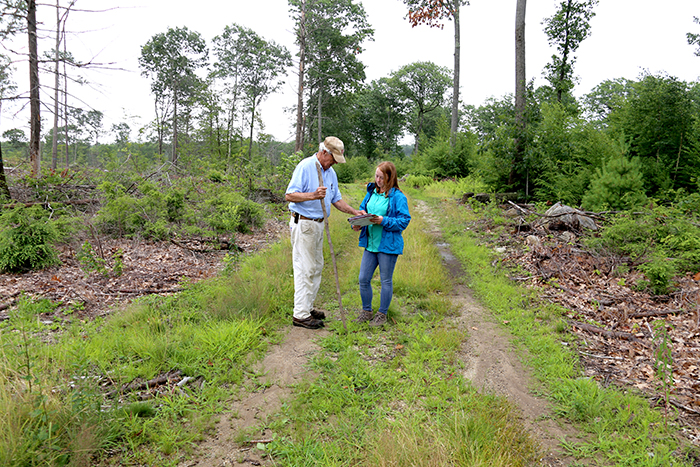Early one morning, in the summer of 2018, Bill Rose was walking through a forested area of his family’s farm in Phillipston, Massachusetts. The area had been thinned as part of a forest conservation project. With just six to 10 trees per acre left standing and scattered brush piles everywhere, the land looked very different than before the cut.
But it wasn’t what he was seeing that got Bill’s attention. It was what he was hearing. He whipped out his smartphone and started recording video, narrating as he scanned his surroundings. “I'm down here on the brand-new oak regeneration cut. And with this brand-new cut, I think you can hear what it does: I'm bringing all the birds in. What a symphony, huh?”
“It was just amazing,” Bill said later.

Diversity in Forests
Jessica Cox, soil conservationist for USDA’s Natural Resources Conservation Service in Worcester County, Massachusetts, worked with Bill on carrying out a number of sustainable forestry practices, which enabled him to manage for younger forests, commonly called early successional habitat. In much of the East, forests lack age class diversity, which has negative impacts on an array of wildlife species.
“A lot of our forests are older, so we're trying to create more young forest to allow different types of wildlife to come back,” Jessica said, adding that wildlife that need young forest includes American woodcock, golden-winged warblers, and New England cottontail.
With the help of NRCS, Bill was able to use the Environmental Quality Incentives Program to help him implement the wildlife-friendly forestry practices.
“Early successional habitat is a forest management practice that involves an extremely heavy cut. It removes most of the trees. It opens the forest floor and allows a dense young forest to come back, which helps wildlife,” explained Cox. “On this property, we did oak regeneration. That was because Bill was interested in songbirds and other small wildlife.”
For Future Generations
Born on the farm in 1934, Rose left for college and went into forestry. When he came back to Red Apple Farm after his father passed away, he wanted to keep the farm going and manage the land to help wildlife for future generations. “I'm the third generation, my son is fourth. He runs the farm now and he's got four kids,” said Rose.
“There are a lot of birds that require open, or combination open, forest,” said Bill. “But there are also quite a few species that need heavy dense young growth – brush, young trees – for nesting, perching, and protection.”
Bill added: “I’d like to see if we can get back ruffed grouse. This dense regrowth will help ruffed grouse because they need a place to hide from hawks and owls. They need a combination of open fields and thick dense young growth. That's the best protection they can get. Same with rabbits; they can hide there. A good briar patch is good for everybody, you know?”
Bill has completed four forest management projects on 120 acres, some with NRCS assistance, some without.
“It's always great to see that projects are doing what they're meant to do,” Jessica said. “It might be two or three years down the road before you see results.”
USDA Assistance
Bill urges other forestland owners to contact NRCS for help. “It's worth looking into. It can help you make the decision to keep your land open for wildlife and for your enjoyment: hiking, hunting, and snowshoeing, or whatever other sports you like to do,” he said.
For more information on how NRCS can help you improve your working forest, farm, or ranch, contact your local USDA service center.
Diane Petit is a public affairs officer with the Natural Resources Conservation Service in Massachusetts. She can be reached at diane.petit@ma.usda.gov.


